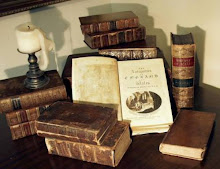We were first introduced to Mr. Burke in 1979 on his television documentary Connections. In each episode of the show, the scientific historian began with a modern object and then reached back in time to show how it came to be: one discovery would lead to a new invention that would provoke a theory that would inspire an experiment that would produce an unforeseen byproduct that would become the essential ingredient for the modern object. An amazing journey.
Circles offers a slight variation on this formula. The dust jacket says each essay follows
a chain of consequential events that ends precisely where it began.We find this statement to be somewhat misleading, because the events are rarely consequential, one resulting from another. Rather the essays follow the connections that take place in Mr. Burke's knowledgeable mind. A good example of this is the connection between an ancient Indian language and identification of the elements: Baron Jon Jacob Berzelius, who established modern chemical symbology, was a "fan" of Karl Gauss, whose method of least squares could accurately predict a planetary orbit, and who had been "affected" by the German enthusiasm for Sanskrit. Another example is the path that leads from Copernicus' De Revolutionibus to Andreas Vesalius' On the Structure of the Body: the editor of Copernicus' book was also the editor of a book by Girolamo Cardano who once cast Vesalius' horoscope. The underlying scheme seems more like "six degrees of separation" than "one thing leads to another."
At times Mr. Burke does shows us how one breakthrough or scientific advance results only from so many previous discoveries: Karl Landsteiner discovered the four blood groups in 1909; in the same year Alexis Carrel developed a new suturing technique; a few years later Charles Lindburgh developed a perfusion pump for Carrel's use in maintaining a body's circulation during a heart operation--all of which helped make possible, and without any one would make impossible, advanced modern surgery. Mr. Burke also makes the point again and again that the first person reputed to have discovered or invented something was usually not, that it had been previously done and forgotten, or the idea was appropriated. The best example of this: Einstein's theory of relativity followed Ernst Mach's, then known as Positivism. And
Mach got Positivism from Comte who got it from St. Simon who got it from Condillac who got it from Locke, who....The book is bursting with interesting facts in nearly every sentence, among them: Francis Scott Key wrote "The Star Spangled Banner" to the tune of Londoner John Smith's song "Anacreon in Heaven;" weather forecasting was generally unscientific and based on myth and magic until French emperor Napoleon III called for the establishment of forecasting services in 1854 (though it sometimes seems forecasts are still no more accurate); in 1946 John Mauchly used vacuum valves to automate calculations in a machine called ENIAC (Electronic Numerical Integrator and Calculator), the world's first electronic computer; there are now eighteen holes on a golf course because in the 1850s the sport became so popular that Royal St. Andrew's split their fairways lengthwise to allow simultaneous play in both directions.
Mr. Burke's style is full of humor and wordplay, making the reading lively. Each essay is only a few pages in length, so the accumulation of facts never becomes tedious. Many times, as in the case of Robert Owen, a person or discovery shows up in several different essays. Of another such person, author Prosper Merimee, Mr. Burke says,
you can't cross the French nineteenth century without bumping into him, since he made it his business to know everybody who was anybody.In this way this book is similar to The Knowledge Web, in which Mr. Burke created a sort of hypertext in print, so that every reference of a person or subject points to the others, allowing the reader to follow his own path through the book.
In his 1985 book The Day the Universe Changed, Mr. Burke presents the theory that when man's views of reality are changed by knowledge, reality itself changes.
Since the structure of reality changes over time, science can only answer contemporary questions about a reality defined in contemporary terms and investigated with contemporary tools. ... There is no metaphysical, super-ordinary, final, absolute reality. There is no special direction to events. The universe is what we say it is.He suggests such a relativist view
might well use the new electronic data systems to provide a structure unlike any which has gone before.Mr. Burke closed his book with this prophetic sentence:
It is time that knowledge became more accessible to those to whom it properly belongs.At the time of his writing, the only TCP/IP network was little more than a university network. The internet did not offer a truly public gateway until 1991. And today, the James Burke Institute for Innovation in Education makes use of this new structure to map the landscape of historical and scientific knowledge. The Institute's Knowledge Web provides an online portal for the exploration of information that allows for an almost infinite number of paths among people, places, things, and events.
Circles and his other books are not to be missed.


No comments:
Post a Comment